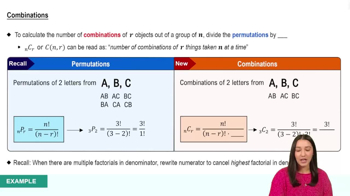Here are the essential concepts you must grasp in order to answer the question correctly.
Combinatorics
Combinatorics is a branch of mathematics dealing with combinations and arrangements of objects. In the context of the handshake problem, it helps determine how many unique pairs can be formed from a group of 'n' individuals. The formula used is based on combinations, specifically 'n choose 2', which calculates the number of ways to select 2 individuals from 'n' without regard to the order.
Combination Formula
The combination formula, denoted as C(n, k) = n! / (k!(n-k)!), is used to find the number of ways to choose 'k' elements from a set of 'n' elements. For the handshake problem, we set k to 2, as each handshake involves a pair of mathletes. This formula simplifies the calculation of handshakes by eliminating the need to list all possible pairs.
Recommended video:
Factorial
A factorial, denoted as n!, is the product of all positive integers up to 'n'. It is a fundamental concept in combinatorics, as it provides the basis for calculating combinations and permutations. In the handshake problem, factorials are used in the combination formula to compute the total number of unique handshakes among 'n' mathletes, ensuring accurate counting of pairs.
Recommended video:
 Verified step by step guidance
Verified step by step guidance Verified video answer for a similar problem:
Verified video answer for a similar problem:


 7:11m
7:11m